Prediction of Well-Being From Isolation, Self-Efficacy, Resilience
Abstract
Well-being is the degree to which an individual is a degree at which has the pleasure of what life brings. The study predicted the positive and negative effects of the joint predictors of isolation, resilience, and self-efficacy on well-being during pandemic times. The study involved 99 participants randomly selected from the UEL Psychology Undergraduates to participate in a survey. The study utilized a correlation regression method design; Warwick-Edinburgh Mental Well-being Scale was used to measure an individual’s well-being. The UCLA loneliness scale and the Brief Resilience Scale was utilised for the resilience scale, and New General Self-efficacy scale was utilised for self-sufficiency. The results showed that well-being is affected by resilience, isolation, and self-efficacy. It is also noted that resilience and self-efficacy positively impact the well-being indicated by linear regression. Prediction of Well-Being From Isolation, Self-Efficacy, Resilience
Keywords: resilience, self-sufficiency, isolation, pandemic times, well-being, correlation
ORDER YOUR PAPER HERE
Well-being is a combination of functioning well and feeling good. It is associated with the experience of having positive emotions such as contentment, happiness, and the development of a person’s potential. It is also related to having control over someone’s life, experiencing positive relationships, and having a sense of purpose (Ruggeri, Garcia-Garzon, Maguire, Matz, & Huppert, 2020). Therefore, well-being is a sustainable condition that allows a person to have positive mental health. Well-being is linked to other factors, such as interpersonal, personal, and professional success (Ruggeri et al., 2020). Therefore, well-being results in positive relationships, prosocial behaviors, increased creativity, and effective learning. In psychology, mental well-being considers mental health-related issues such as effects, depression, and anxiety. It is divided into two major categories: hedonic well-being, which is associated with positive subjective feelings such as happiness. The other category is eudaimonic well-being, which is related to positive functioning.
Hedonic well-being is derived from ethical hedonism, which refers to satisfaction and pleasure, often operationalised as subjective well-being. This is an aggregate of a person’s scores on three different constructs: high life satisfaction, low NA, and increased PA.
Research Question
Can we predict mental well-being in pandemic times from the joint predictors of isolation, resilience, self-efficacy, and positive/ negative affect? Prediction of Well-Being From Isolation, Self-Efficacy, Resilience
Research Aim
This research aims to predict the positive and negative effects of the joint predictors of isolation, resilience, and self-efficacy on well-being during pandemic times.
Study Rationale
Human beings are made to adapt to the social cognitive process in their daily lives. Isolation, resilience, and self-efficacy impact individuals’ well-being, which is determined by how the individual can cope with the challenges and one’s ability to cope with the stressors. During the pandemic, it is notable that individuals had to cope with health stressors and responded in diverse manners. Personal psychological factors and social support during the pandemic determined the influence of isolation, resilience, and self-efficacy on an individual’s well-being. Therefore, this study needs to predict isolation, self-efficacy, and resilience outcomes on well-being during the pandemic.
Study Hypothesis
H1 mental well-being is affected by isolation, resilience, and self-efficacy.
H1a, mental well-being is positively affected by self-efficacy and resilience.
H2b the mental well-being is negatively affected by isolation.
Predictor variables
The study exhibited both dependent and independent variables: isolation, resilience, and self-efficacy, and the dependent variable being well-being Prediction of Well-Being From Isolation, Self-Efficacy, Resilience.
Methods
Participants
In the study, 99 participants were randomly selected from UEL Psychology Undergraduates to participate in survey. The gender of the participants, eighty-seven females, eight males, and four, could not disclose their gender. Participants aged between 18-58 years, and one participant was excluded for not giving correct information leading to 98 participants.
Design
The research utilised a correlational multiple regression approach. The link between the contribution to the prediction factors (independent variables) and the outcome-dependent variables was ascertained using various regressions.
Materials
Qualtrics powered the study was utilised. The results of the evaluation of the measurements were as shown below:
Well being scale
Warwick-Edinburgh Mental Well-being Scale was utilised; it exhibited 14 items with five responses to cover an individual’s feelings, adding to the overall score.
Isolation scale
The study utilised the UCLA loneliness scale with three items for the isolation scale (Garg, Sharma, & Burgess, 2023)Prediction of Well-Being From Isolation, Self-Efficacy, Resilience. The scale was used to predict how an individual feels.
Resilience scale
The Brief Resilience Scale was utilised for the resilience scale; the program requires users to rate how much individuals concur or dispute six assertions (Labrague, 2021).
Self-sufficiency scale
New General Self-efficacy scale that contained eight questions was utilised (Whitehall, Rush, Górska, & Forsyth, 2020)Prediction of Well-Being From Isolation, Self-Efficacy, Resilience. It aimed to measure one’s ability to carry out tasks given and how the respondent feels about themselves.
Procedure
The study began when the participants were randomly selected from the UEL Psychology Undergraduates to participate in the survey. Informed consent was sought from the participants to ensure that the participants were fully aware of the study before commencing and participants’ privacy was followed. Additionally, permission from the institution to carry out the survey was also sought.
Results
The study data involved only 98 participants since one participant could not respond correctly and was excluded from the study.
Descriptive statistics
| Statistics | |||||
| Well-being | Resilience | Isolation | Self-efficacy | ||
| N | Valid | 98 | 98 | 98 | 98 |
| Missing | 1 | 1 | 1 | 1 | |
| Mean | 44.97 | 18.93 | 5.74 | 29.40 | |
| Std. Deviation | 9.686 | 5.724 | 1.846 | 6.645 | |
| Range | 48 | 30 | 8 | 40 | |
| Minimum | 21 | 0 | 1 | 0 | |
| Maximum | 69 | 30 | 9 | 40 | |
Table 1: descriptive statistics of the variables
Figure 1: Frequency Distribution of the Variables
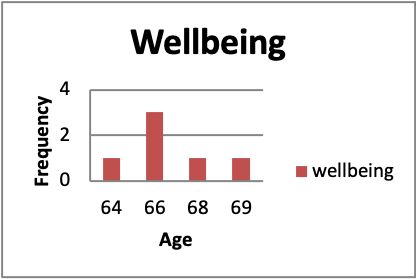
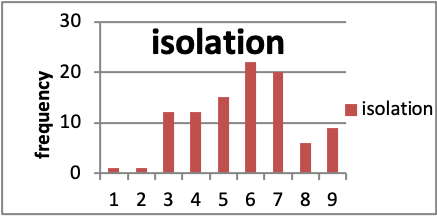
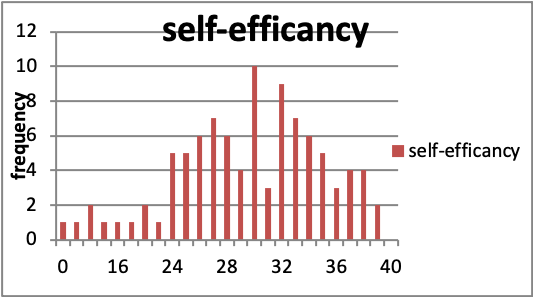
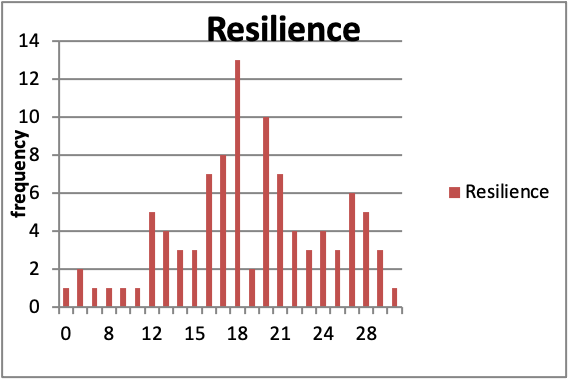
Inferential statistics
The study’s four variables: well-being, isolation, self-efficacy, and resilience, were correlated using the Pearson correlation. The quasi-normative histograms of the Pearson Correlation made it possible to analyse the many parameters, making it the best method for this research.
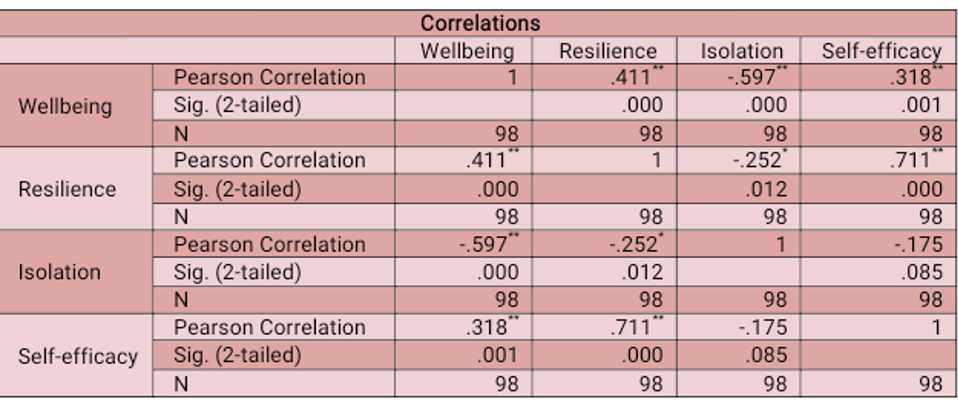
As evidenced by the connection of happiness to all the factors, all the p-values indicated by the (Sig.) feature are statistically meaningful. The influence of the predictor factors on well-being got extensively investigated using the linear regression technique.

The linear regression above indicates that well-being is affected by resilience, isolation, and self-efficacy. It further demonstrates that isolation had -2.763, suggesting that it negatively affects well-being, which agrees with the study’s hypothesis. It is also noted that resilience and self-efficacy positively impact the well-being, as depicted by their positive Beta coefficients of 0.236 and 0.58, respectively.
ORDER HERE
Discussion
The findings in the study aid in explaining the impact of the pandemic on the general well-being determined by the three variables resilience, isolation, and self-efficacy. The linear regression utilised in the study expounded on the effects of each variable; it is depicted that isolation negatively impacted the well-being supporting the study’s hypothesis (H2b). The pandemic led to lockdowns in most parts of the world and, in this case, isolated most people. Additionally, those individuals who were found to be positive for Covid-19 had to be isolated from the rest of the people to avoid the spread of the virus; isolation, therefore, altered the well-being of the people as some feared getting themselves in isolation (Hsieh et al., 2020). Individuals also expressed their fear of being taken to the hospital or isolation centres and the change in lifestyles, such as social distancing and more repetitive messages on evading the pandemic. Therefore the isolation shows that it negatively impacted well-being, as shown in figure 3. Self-efficacy fosters the propensity to remain resilient in the face of challenging situations. Self-efficacy promotes resiliency by activating psychological and cognitive factors. As a result, this can resolve how to experience improved well-being; this indicates the reason resilience and self-efficacy remain positive in figure 3 (Cohrdes & Mauz, 2020)Prediction of Well-Being From Isolation, Self-Efficacy, Resilience. Resilience facilitates adaptation to the present changing problem and one’s ability to stay strong. That is why resilience positively impacted well-being despite the impact of the pandemic.
The limitation of the study is that some respondents could have just given the wrong information to complete the survey. It is difficult to ascertain whether the respondents were biased, and in the future, there is also a need to inform the respondents of the importance of giving genuine responses.
Conclusion
The study indicates that the three variables have an impact on the overall well-being of an individual. It is characterised by the results obtained in the survey showing that resilience, self-efficacy, and isolation affect an individual’s well-being. Prediction of Well-Being From Isolation, Self-Efficacy, Resilience